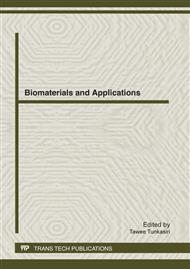p.465
p.469
p.473
p.477
p.481
p.485
p.489
p.493
p.497
Comparison of Vehicles for Vancomycin Drug Delivery in Extemporaneously Prepared Ophthalmic Solutions
Abstract:
This work compares the ophthalmic delivery of vancomycin 50 mg/ml eye drops using 5 different vehicles, namely: 0.3% w/v chitosan, 0.3% and 0.4% w/v HPMC (Methocel E4M), Tears NaturaleTM II and 0.9% w/v sodium chloride solution. In vitro and in vivo studies were carried out and the results evaluated in terms of viscosity, compatibility, stability, clarity, minimum inhibitory concentration (MIC) and pharmacokinetics. The viscosity of Tears NaturaleTM II was comparable with that of HPMC (0.3% pH 7.1) but was higher than 0.3% w/v chitosan. The percent labeled amounts and MIC of vancomycin 50 mg/ml in all of the vehicles were stable for 30 days at 2-8°C, while the clarity in 0.3% w/v chitosan, 0.3% and 0.4% HPMC (pH 7.1), Tears NaturaleTM II and 0.9% sodium chloride solution was stable for 30, 14, 1 and 3 days respectively at 2-8°C. In vivo pharmacokinetic determinations of the AUC of tear film reciprocal of minimum inhibitory titer showed that vancomycin 50 mg/ml in 0.3% w/v chitosan, 0.3% and 0.4% w/v HPMC pH 7.1 and Tears NaturaleTM II were significantly different from 0.9% sodium chloride solution. At the present time, chitosan is undergoing clinical trials in Thailand with a view to its use in ophthalmology, while HPMC (0.3% w/v) in pH 7.1 has already been approved for use as a vehicle in ophthalmology for the delivery of vancomycin 50 mg/ml in extemporaneous eye drops.
Info:
Periodical:
Pages:
481-484
Citation:
Online since:
April 2012
Authors:
Keywords:
Price:
Сopyright:
© 2012 Trans Tech Publications Ltd. All Rights Reserved
Share:
Citation:


